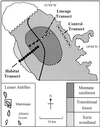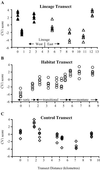Molecular evidence for ecological speciation in tropical habitats
- PMID: 12370440
- PMCID: PMC129722
- DOI: 10.1073/pnas.212248499
Molecular evidence for ecological speciation in tropical habitats
Abstract
Recent research on rainforest speciation has highlighted the importance of habitat variation in generating population diversification but lacks evidence of an associated reduction in gene flow. This paper describes a study in which molecular markers were used to examine the effects of allopatric divergence and habitat on levels of gene flow in the Caribbean lizard, Anolis roquet. Three study transects were constructed to compare variation in microsatellite allele frequencies and morphology across phylogenetic and habitat boundaries in northern Martinique. Results showed reductions in gene flow to be concordant with divergent selection for habitat type. No evidence could be found for divergence in allopatry influencing current gene flow. Morphological data match these findings, with multivariate analysis showing correlation with habitat type but no grouping by phylogenetic lineage. The results support the ecological speciation model of evolutionary divergence, indicating the importance of habitats in biodiversity generation.
Figures



Similar articles
-
The roles of allopatric divergence and natural selection in quantitative trait variation across a secondary contact zone in the lizard Anolis roquet.Mol Ecol. 2008 Dec;17(23):5146-56. doi: 10.1111/j.1365-294X.2008.03979.x. Mol Ecol. 2008. PMID: 19120993
-
Genetic tests for ecological and allopatric speciation in anoles on an island archipelago.PLoS Genet. 2010 Apr 29;6(4):e1000929. doi: 10.1371/journal.pgen.1000929. PLoS Genet. 2010. PMID: 20442860 Free PMC article.
-
Divergence in coloration and ecological speciation in the Anolis marmoratus species complex.Mol Ecol. 2013 May;22(10):2668-82. doi: 10.1111/mec.12295. Mol Ecol. 2013. PMID: 23611648
-
Ecological and genetic divergence between two lineages of middle American túngara frogs Physalaemus (= Engystomops) pustulosus.BMC Evol Biol. 2010 May 18;10:146. doi: 10.1186/1471-2148-10-146. BMC Evol Biol. 2010. PMID: 20482771 Free PMC article.
-
Lizards as model organisms for linking phylogeographic and speciation studies.Mol Ecol. 2010 Aug;19(16):3250-70. doi: 10.1111/j.1365-294X.2010.04722.x. Epub 2010 Jul 8. Mol Ecol. 2010. PMID: 20618905 Review.
Cited by
-
The influence of gene flow and drift on genetic and phenotypic divergence in two species of Zosterops in Vanuatu.Philos Trans R Soc Lond B Biol Sci. 2010 Apr 12;365(1543):1077-92. doi: 10.1098/rstb.2009.0281. Philos Trans R Soc Lond B Biol Sci. 2010. PMID: 20194170 Free PMC article.
-
Factors affecting interspecific differences in genetic divergence among populations of Anolis lizards in Cuba.Zoological Lett. 2018 Aug 9;4:21. doi: 10.1186/s40851-018-0107-x. eCollection 2018. Zoological Lett. 2018. PMID: 30116552 Free PMC article.
-
Elevation in tropical sky islands as the common driver in structuring genes and communities of freshwater organisms.Sci Rep. 2017 Nov 23;7(1):16089. doi: 10.1038/s41598-017-16069-y. Sci Rep. 2017. PMID: 29170522 Free PMC article.
-
Inter- and intraspecific genetic and morphological variation in a sibling pair of carabid species.Saline Syst. 2007 Apr 24;3:4. doi: 10.1186/1746-1448-3-4. Saline Syst. 2007. PMID: 17456232 Free PMC article.
-
Ecological reproductive isolation of coast and inland races of Mimulus guttatus.Evolution. 2008 Sep;62(9):2196-214. doi: 10.1111/j.1558-5646.2008.00457.x. Epub 2008 Jul 14. Evolution. 2008. PMID: 18637837 Free PMC article.
References
-
- Moritz C, Patton J L, Schneider C J, Smith T B. Annu Rev Ecol Syst. 2000;31:533–563.
-
- Smith T B, Schneider C J, Holder K. Genetica. 2001;112:383–398. - PubMed
-
- Smith T B, Wayne R K, Girman D J, Bruford M W. Science. 1997;276:1855–1857.
-
- Magurran A E. Philos Trans R Soc London B. 1998;353:275–286.
Publication types
MeSH terms
Associated data
- Actions
- Actions
- Actions
- Actions
- Actions
- Actions
- Actions
- Actions
Grants and funding
LinkOut - more resources
Full Text Sources

